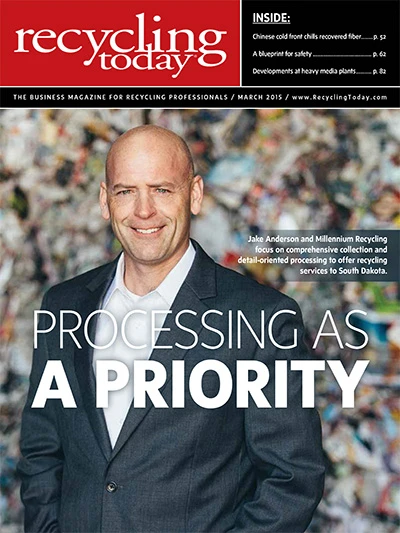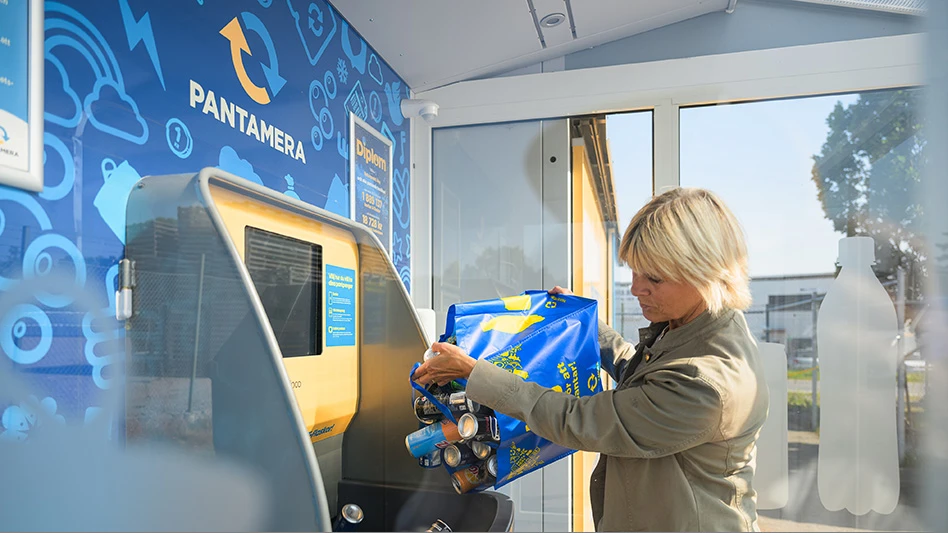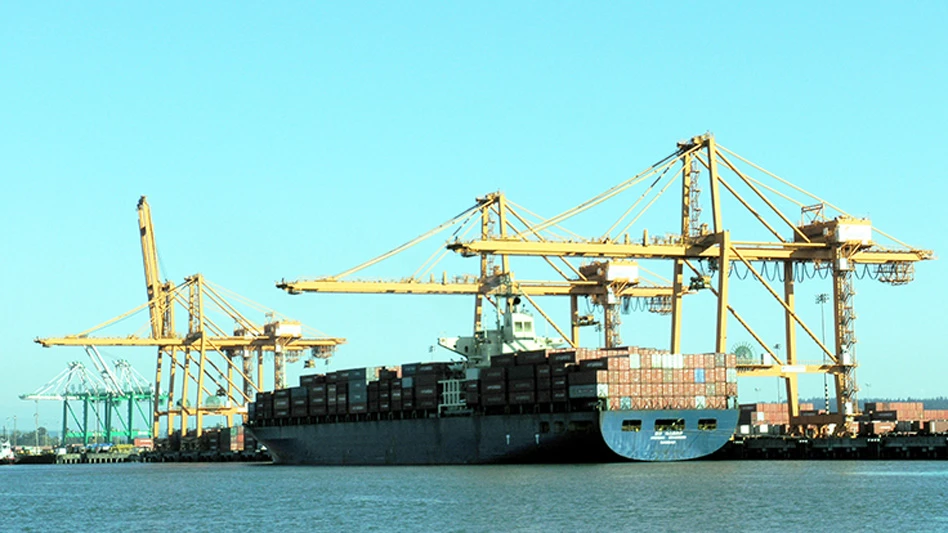 One recurring theme at the 2014 edition of the European Paper Recycling Conference, held in Milan last October, was the role of export markets in influencing domestic or regional outcomes. More specifically, speakers and attendees were keen in understanding how slower import growth from China could affect the European recovered paper balance in the future. The question of China’s slowdown is one that concerns most commodity markets. But within forest products, recovered paper is arguably the segment that is affected the most, given the Asian giant’s enormous weight in global trade flows of secondary fiber.
One recurring theme at the 2014 edition of the European Paper Recycling Conference, held in Milan last October, was the role of export markets in influencing domestic or regional outcomes. More specifically, speakers and attendees were keen in understanding how slower import growth from China could affect the European recovered paper balance in the future. The question of China’s slowdown is one that concerns most commodity markets. But within forest products, recovered paper is arguably the segment that is affected the most, given the Asian giant’s enormous weight in global trade flows of secondary fiber.
As the world’s leading producer of recycled-content-based paper and board, any development affecting China’s tendency to import recovered paper—be it lower demand, regulatory changes or higher collection rates—has an immediate impact on this material’s usage and availability in most regions of the world. When these changes are significant, the result can be highly disruptive, highlighting the susceptibility of recovered fiber markets to sudden variations in external demand.
 To illustrate the effect of external fluctuations on regional outcomes, this article discusses the medium-term outlook for the Western European OCC (old corrugated containers) market, Europe’s largest recovered fiber segment and the one with the greatest reliance on overseas deliveries.
To illustrate the effect of external fluctuations on regional outcomes, this article discusses the medium-term outlook for the Western European OCC (old corrugated containers) market, Europe’s largest recovered fiber segment and the one with the greatest reliance on overseas deliveries.
Containerboard outlook
When assessing the role of exports in any commodity market, it is important to first develop a clear understanding of the main end uses of the sector being analyzed. In Europe, roughly 85 percent of all OCC consumed is used as furnish in containerboard manufacturing, a segment that is exceptionally sensitive to business cycle fluctuations. More than for any other paper grade, changes in containerboard output are strongly correlated to shifts in aggregate demand, particularly to changes in nondurable goods manufacturing. Thus, whether shocks to external demand result in shortages or surpluses of OCC in the European market will largely depend on the current input requirements of containerboard mills, which will in turn bank on the strength of the macroeconomy.
 Production of consumer nondurables in the euro zone rose 3.8 percent year over year in October and is up 3.2 percent year to date. Despite these signs of recovery, however, production of fast-moving consumer goods remain slightly below their prerecession peak. Lackluster growth in nondurables manufacturing, combined with a substantial decline in production of consumer durable goods, has restrained regional demand for industrial packaging.
Production of consumer nondurables in the euro zone rose 3.8 percent year over year in October and is up 3.2 percent year to date. Despite these signs of recovery, however, production of fast-moving consumer goods remain slightly below their prerecession peak. Lackluster growth in nondurables manufacturing, combined with a substantial decline in production of consumer durable goods, has restrained regional demand for industrial packaging.
Looking ahead, we expect containerboard deliveries in Western Europe to rise between 1.5 percent and 2 percent per year through 2017. While this is not an implausible scenario, the outlook for European manufacturing clearly has weakened in recent months. This is primarily a consequence of Germany’s current economic slowdown.
As soft demand spreads to the core of the monetary union, the European Central Bank’s (ECB’s) goal of avoiding deflation will become an increasingly challenging task. Core inflation lies well below the lower bound of the ECB’s target range, and, with production trailing below potential, deflationary pressures are unlikely to subside. Headline inflation already has started to decline on the back of falling energy prices. A direct consequence of outright deflation is that it would prompt consumers to postpone purchases of big-ticket items. Private spending would be further restrained by the rising real value of debt. Given these two possibilities, the success of the ECB’s sovereign bond purchase program in raising inflation expectations appears crucial in ensuring a sustained recovery of domestic demand. Even if private purchases failed to accelerate, export markets will nevertheless provide some relief to European manufacturers, as the ECB’s expansionary stance will at the very least prevent the euro from appreciating.
The weak euro also will benefit containerboard exports, so that total containerboard output will outpace growth in Western European demand for liner and medium. For the purposes of predicting OCC consumption, however, it’s not only changes in total output that matter but also whether this increase will be met using virgin or recycled containerboard.
In Western Europe, the overwhelming majority of OCC is used by recycled containerboard producers. Not only is this a much larger segment than virgin containerboard in volume, but, based on our own estimates, secondary fiber also represents nearly 95 percent of the total fiber furnish in the manufacturing process. For kraftliner and semichemical medium, on the other hand, we believe this share to be lower than 30 percent.
Broken down by grade, we anticipate production gains will primarily come from the recycled segment, where most capacity additions are to take place in the years ahead. Between 2014 and 2017, recycled containerboard capacity in Western Europe is scheduled to rise by more than 1 million metric tons, while virgin containerboard capacity is set to increase by less than half.
|
Upward momentum Recovered paper pricing has been in a slump in late 2014 and early 2015, according to paper and recycling industry consultant Bill Moore of Moore & Associates, Atlanta. Speaking to attendees of Paper Recycling Conference India, held in New Delhi in late January, Moore described a list of variables that affect scrap paper pricing, several of which may soon conspire to boost prices upward. Among the most important variables, Moore said, is the global economy, which in many places is healthier than current recovered fiber prices might indicate. For some grades, the cost to recover additional tons can affect price, which Moore says is why the old newspapers (ONP) and old magazines (OMG) grades have been faring better in late 2014 and 2015. Those two grades, he said, are in “chronically short supply” as print media circulation numbers in North America and Europe continue to decline. A variable that is suppressing prices on the OCC (old corrugated containers) side of the market are low mill operating rates in the world’s largest containerboard production market—China. Moore said he foresees that China’s excess board mill capacity “will be soaked up [but] it will take a while.” China’s excess capacity and a prolonged economic slump in Europe have been the biggest contributors to the current price slump, Moore says. He predicted, however, that “we are at the bottom end of the cycle. Prices will go back up.” Rising prices, though, may not hit peaks that were as high as those in China’s fastest growth years of the previous decade, Moore commented. Among the restraints are slower economic growth rates in China and the ability of mills in the U.S. Southeast to use wood chips if recovered fiber prices become impractically high. Moore said China and India likely will focus on increased domestic collection, as North America and Europe are “almost at maximum recovery.” Among the other variables that will affect scrap paper pricing in 2015 and beyond, he said, are virgin pulp prices, ocean freight shipping costs, currency exchange rates, disposal (landfill) costs and inventory levels at large paper mills. The Recycling Today Media Group’s Paper Recycling Conference India was Jan. 29-30 at the Taj Palace Hotel in New Delhi. |
Given our expectations for the European containerboard industry, the issue becomes: By how much would OCC consumption need to increase to meet this production requirement? This is a difficult question to answer, as OCC demand not only depends on conditions in its end markets but also on mill production technologies and on the ease of substitution between material inputs (in this case, primarily virgin pulp and mixed scrap paper). A change in the fiber composition of containerboard in favor of recycled pulp, for instance, would increase the quantity of OCC consumed for any level of output. Similarly, a decline in its yield would call for a higher quantity of OCC processed per metric ton of output produced. While a protracted decline in the OCC yield seems particularly plausible in a region dominated by recycled-based packaging, the conversion of Stora Enso’s PM No. 3 at Varkaus, Finland, this year will partly alleviate the progressive shortening of the average fiber length in OCC bales.
Export's role
Suppose that OCC quality does not diminish over the next three years and that the composition of the furnish mix remains unchanged. Then, assuming Western European containerboard production grows at an average annual rate of 2 percent, OCC usage would have to increase by roughly 2.2 percent per year. This is the point where export markets come into play. Whether this increase in consumption is actually attainable will depend on domestic availability of OCC, which is in turn conditional on external OCC demand and on the collection rate. In Europe, the role of exports is particularly prominent considering the apparent recovery rate of OCC (i.e., excluding net imports of boxed goods) already exceeds 100 percent. Thus, whether enough OCC will be available for containerboard manufacturing will depend on the evolution of trade flows.
Broadly speaking, the lower the rate of growth of net OCC exports, the easier it will be for the European OCC market to balance. Western Europe, like North America, has a surplus of OCC. In the first nine months of last year, 20 million metric tons of OCC were collected in the region, exceeding regional consumption by about 5 million metric tons. This means that one-quarter of all OCC collected was shipped abroad, a much higher percentage than for the other recovered paper grades. (In terms of newspapers, for instance, the export share was roughly 10 percent.) It is precisely this reliance on exports that makes the OCC market so vulnerable to external shocks. This issue is exacerbated by a surprising lack of diversification in the destination countries: More than 80 percent of Europe’s OCC exports are shipped to China, with only a small percentage sent to India, Indonesia and other growth markets. This suggests that a sharp drop in China’s purchases of European OCC easily could result in excess supply in the European market. This situation could not be easily addressed given the segment’s excessive exposure to a single export market.
Chinese imports
A persistent decline in Chinese imports is a real possibility. Chinese OCC imports slipped 7.1 percent during the first 11 months of last year, with shipments from Western Europe falling 5.1 percent. While several reasons are behind this decline, tighter environmental regulations and slow growth in containerboard demand are arguably the two most important ones.
The slowdown of Chinese OCC imports started in early 2013, following the implementation of Operation Green Fence, an initiative meant to improve the quality and environmental standards of imported recovered material. Although the measure expired in November of that year, tighter regulation has remained in place. In particular, anecdotal evidence suggests Chinese mills that previously purchased bales with a high degree of contaminants are less willing to do so following Green Fence. This occurs at a time when the quality of China’s collection and sorting systems is improving, making local producers even less prone to purchase foreign OCC bales.
Sponsored Content
Labor that Works
With 25 years of experience, Leadpoint delivers cost-effective workforce solutions tailored to your needs. We handle the recruiting, hiring, training, and onboarding to deliver stable, productive, and safety-focused teams. Our commitment to safety and quality ensures peace of mind with a reliable workforce that helps you achieve your goals.
Sponsored Content
Labor that Works
With 25 years of experience, Leadpoint delivers cost-effective workforce solutions tailored to your needs. We handle the recruiting, hiring, training, and onboarding to deliver stable, productive, and safety-focused teams. Our commitment to safety and quality ensures peace of mind with a reliable workforce that helps you achieve your goals.
Sponsored Content
Labor that Works
With 25 years of experience, Leadpoint delivers cost-effective workforce solutions tailored to your needs. We handle the recruiting, hiring, training, and onboarding to deliver stable, productive, and safety-focused teams. Our commitment to safety and quality ensures peace of mind with a reliable workforce that helps you achieve your goals.
Importantly, import substitution probably will affect Western European exporters more so than their North American counterparts because North American OCC bales are, on average, comprised of boxes with a much higher virgin content, giving U.S. exporters a quality premium. A weaker euro should only partly offset this factor in our view.
Aside from tighter environmental regulations, a major problem for both European and North American exporters is the dismal performance of the Chinese containerboard industry in the recent past. Despite 21 new containerboard machines being brought online between 2012 and 2013, Chinese containerboard supply contracted for the first time in 18 years in 2013. This year, we expect it to grow less than 1 percent and for this slow pace of growth to continue in the next few years.
Weak packaging demand is fundamentally a consequence of slower industrial activity. Manufacturing production in China is currently held back by excess capacity and weak real estate activity. Industries catering directly to the housing market have seen the greatest declines, with segments like glass or cement even posting outright contraction in recent months. Looking ahead, we expect this slowdown to continue, as the government gradually reduces its dependence on infrastructure investment in favor of household spending. While consumers may benefit from this transition, we do not expect containerboard demand to accelerate sharply in the foreseeable future.
Net effect
Assuming import restrictions do not lessen, then based on our current projections for Chinese packaging demand (as well as on our expectations of a decline in the euro-renminbi exchange rate), we anticipate Western European OCC exports to China will grow 0.3 percent per year through 2017. Obviously, should Chinese containerboard demand turn out to be weaker than anticipated, or if Chinese OCC recovery rates rise markedly during this period, then export growth will turn out to be negative.
At this level of exports, however, only a mild shortage would actually arise in the Western European market, as local consumption needs would slightly outpace domestic availability. Therefore, we do not believe that exports will exert any significant upward pressure on OCC pricing over the next year or two. The diminishing quality of OCC available in Europe, however, does have the potential to do so. But in our view, this will play out over a longer period of time.




The author is an economic analyst primarily responsible for the containerboard and recovered fiber sectors for Montreal-based Numera Analytics. He can be contacted at jklara@numeraanalytics.com.
Get curated news on YOUR industry.
Enter your email to receive our newsletters.

Explore the March 2015 Issue
Check out more from this issue and find your next story to read.
Latest from Recycling Today
- Nucor expects slimmer profits in early 2025
- CP Group announces new senior vice president
- APR publishes Design Guide in French
- AmSty recorded first sales of PolyRenew Styrene in 2024
- PRE says EU’s plastic recycling industry at a breaking point
- Call2Recycle Canada, Staples Professional expand partnership
- Circular Services breaks ground on north Texas MRF
- Tariff uncertainty results in choppy nonferrous scrap flows







